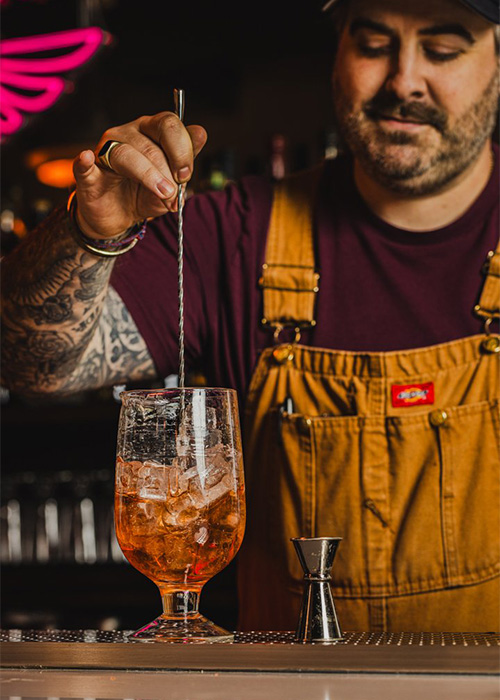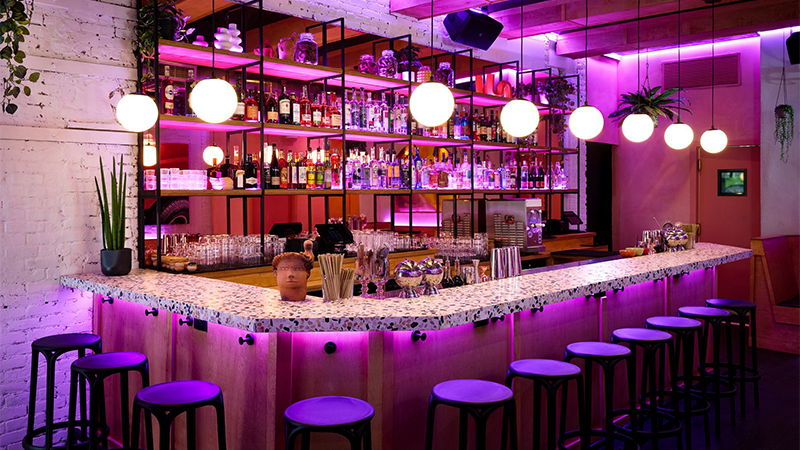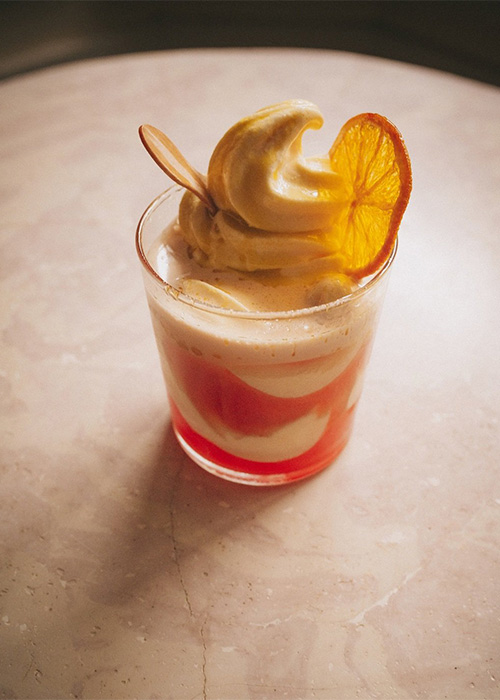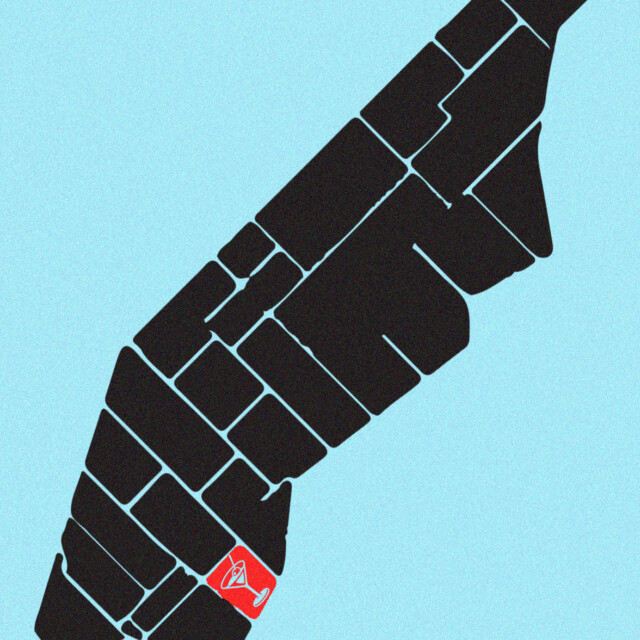In April, New York City’s Superbueno earned the No. 2 spot on North America’s 50 Best Bar list. Their top-selling drink is a Vodka Soda. The Vodka Y Soda isn’t just a two-ingredient highball; they add guava and pasilla into the mix, and the result is refreshing and intensely flavorful. Still, it’s a well drink at heart, served by an acclaimed, white-hot bar in the East Village. There’s a lot to unpack.
Ten years ago, Vodka Sodas weren’t the kind of drink you ordered at the bars that made East Village the soul of New York City’s globally influential cocktail scene. That was a drink strictly reserved for one of the neighborhood’s numerous dank, sticky-floored dive bars, where drink expectations beyond a beer and a shot were low and the quality of the Vodka Soda even lower. You went to places like Please Don’t Tell, Amor y Amargo, or Death & Co. to learn about classic cocktails, dig deeper into somewhat esoteric spirits and liqueurs, and to be amazed by the spectacle of a speakeasy inside a hot dog joint or a 17-touch craft drink. They offered fun experiences bracketed by studious reverence, becoming award-winning, neighborhood-defining establishments in the process.
Fast-forward to 2024. These old-school bars have graduated to legacy status, and a new generation of bars are forging their own path. Superbueno’s a celebration of warm, upbeat Mexican-American hospitality. Paradise Lost integrates the retro coolness of a classic Southern California tiki bar with the East Village’s gritty punk rock ethos to create hell’s version of a tropical joint. Romeo’s, helmed by alumni of fellow EV-staple Virginia’s, offers a chill spot for fancy drinks and basic highballs in an aesthetic that references the ‘90s. Each of these bars is a year old or less. They are also the new East Village tastemakers shifting the cocktail bar scene’s vibe to something that infuses modern technique and skill with the casual, punk-rock ethos of the East Village dives of yore — albeit with less graffiti in the bathrooms.
This shift may look surprising on the surface. Dig a little deeper, and it begins to look inevitable.
Changing Tides
The East Village’s first craft cocktail bar, Angel’s Share, opened in 1993 when the rest of the world was still pounding drinks made from powdered mixes and frozen juices from concentrate. Other more well-known bars in the neighborhood, influenced by Angel’s Share’s commitment to precision and quality, began popping up in the neighborhood a decade later. These places taught guests the beauty and brilliance of cocktails by stripping away the looser, more casual elements of bar culture.

Time has passed. Cocktails have gone mainstream, to the point where it’s possible to stumble upon a dive bar whipping up a halfway decent Negroni. Guests aren’t wowed as easily, either. A burgeoning sense of customer malaise that some bartenders began to detect in the late 2010s skyrocketed during the pandemic, when sheltered patrons learned how to make cocktails with the fancy techniques that used to blow their minds. Now, they want a bar’s looser components back to complement that polish.
“We don’t always want to go to a place where we need to shut up and sit down, especially if we’re going to spend $26 on a drink,” explains Romeo’s owner Evan Hawkins. “People are getting tired of that. They really don’t give a f*ck as long as the cocktail they order is good.”
This somewhat jaded indifference toward cocktails provides the new wave of East Village bars with a different type of educational opportunity. This brings us back to the Vodka Soda, a drink that many cocktail snobs have rendered beneath them for years. These new establishments are now reeducating cynical imbibers about the joys of a basic, unfussy highball. The popularity of Superbueno’s riff demonstrates these tactics at work, but it’s ultimately the reactions to the drinks themselves that are closing the deal.
“Guests want to be surprised,” Hawkins states. “Those kinds of easy, simple drinks create little moments of surprise. That’s the hook. That’s education. It’s hard to educate with words. It’s much easier to educate with moments.”
Forged in Fire
Covid gave bar professionals ample time to ponder what was missing in the East Village. Once the pandemic subsided, some seized the opportunity to fill these voids with something more buttoned down, but also layered and self-reflective. When Ignacio “Nacho” Jimenez sketched out the concept for Superbueno, he intended it to be a response to lack of Mexican-American representation in the bar scene. He also wanted to integrate hospitality and cultural identity in the space without building a cantina-style restaurant or a tequilaria. The result was a boisterous bar, but there’s also something more intimate embedded in the vibrancy.

“Superbueno is a Mexican-American cocktail bar, but it also creates this experience that tells my history and journey, from my home in Mexico to my journey in New York City,” Jimenez says. “This makes Superbueno personal, and when you make a bar so personal, no one else can tell you what ‘personal’ is.”
“An erupted volcano creates a new path. Now that we’re on the other side, we’re seeing the seeds planted during Covid sprout. There is new talent coming to the scene with new ideas, and it’s great to see these flowers.”
The lockdown also gave Paradise Lost’s partners Kavé Pourzanjani, Josh Very, and Ray Sakover the bandwidth to figure out how to make an intentional tropical spot that simultaneously preserved the coolness of the aesthetic and pushed for positive change. Amid the venue’s escapist fun and occasionally flaming bar-top is a commitment to righting wrongs; a portion of sales goes directly to organizations that support and advocate for Polynesian communities.
The East Village’s vibe shift is indeed, in large part, a product of dark times. But these new concepts also represent a retroactive silver lining that is just starting to come into view.
“I don’t want to take away from the damage the pandemic caused, because it took a lot away from us,” says Paradise Lost’s head bartender, Kitty Bernardo. “But it was like any disaster. An erupted volcano creates a new path. Now that we’re on the other side, we’re seeing the seeds planted during Covid sprout. There is new talent coming to the scene with new ideas, and it’s great to see these flowers.”
In Tune With the Past
The East Village’s soul comes from bohemian creatives desiring to do things differently. It’s the neighborhood of the Ramones and CBGB, of Jean-Michel Basquait and Keith Haring. It’s the home of the Tompkins Square Park riots (both of them). Pushing back against the norm in the name of progress or artistic statement is, and always has been, the expectation.
This is true of the bar scene’s block-by-block evolution. Any new cocktail bar in the neighborhood that’s rejecting austerity and embracing a more buttoned-down environment taps into the neighborhood’s creative and rebellious energy. They do so with a caveat: They understand the establishment were once the norm-defying rebels.
“When Amor y Amargo opened, they were [the bar current scene’s] counterculture,” Bernardo says. “They were a bitters bar with no juices or sodas, and this allowed guests to experience a new take on cocktails. Death & Co was the same way. They were serious, moody, and dark with these meticulous handcrafted cocktails. It was almost like cocktail omakase, and it felt like meditation. What’s happening now with these new bars is a current form of counterculture, and it makes you wonder what the next form of counterculture might be.”
Old-School Support
These legacy bars within the East Village don’t feel threatened by new ideas and philosophies penetrating the neighborhood. They treat them as welcome additions that further the area’s reputation for being what’s arguably the straw that stirs the New York City bar scene. Moreover, some feel like it’s their duty to be as supportive as possible.
“People put a path for me, and they cleared that path with a machete,” says Sother Teague, beverage director at Amor y Amargo. “So, it’s important for me to continue flattening the land to make that path smoother for the next generation.”
Teague’s sentiment brings to mind a phrase hospitality veterans are wont to periodically utter: “A rising tide raises all boats.” This phrase holds a little more water in this small neighborhood. Its density and lack of subway stops organically lend itself to local bar crawls of both low and high brow. Every East Village bar new and old understands this, and it compels them to constantly bring their A game — something that pays dividends in the long run.
“Why do we go out to drink? It’s not for the cocktail. It’s for the connection. The East Village scene is getting back to these roots, and I’m here for it.”
“The scene is competitive, but it’s supportive,” Jimenez says. “We have found great success in building community within the industry. It’s always gratifying to hear guests tell us they were sent our way from another bar that we love.”
For the legends, being part of this competitive yet supportive landscape is to not rest on their laurels. “Just because you’re a legacy bar, you can’t omit yourself from being relevant today,” says Javelle Taft, bar manager for Death & Co NYC. One of the ways Taft achieves this is by visiting the surrounding blocks’ new bars and gleaning insights from their beverage programs. These visits also help him be a better steward to his patrons as they traipse through the neighborhood. “It’s important to appreciate the different atmospheres of these places, because it helps me figure out the right places to send our guests next,” he says.

The support for the East Village’s shift in vibe also comes from their neighbors in the Lower East Side, home to their own legacy bars like Attaboy and Bar Goto. That neighborhood is going through its own transition into more relaxed, playful cocktail havens, albeit at a slower pace. These new spaces also stem from purpose: When partners Harrison Snow and Jake Hodas opened Lullaby in 2022, they launched it as a rejection of what they called the “ivory tower” ethos found in some of the previous generation’s more austere, studious bars. Snow and Hodas have a great appreciation for what’s happening in the East Village, particularly because the new wave is offering authentic experiences that are conducive to promoting a bar’s true purpose.
“The product isn’t the cocktail. It’s the experience,” Hodas says. “Why do we go out to drink? It’s not for the cocktail. It’s for the connection. The East Village scene is getting back to these roots, and I’m here for it.”
The Future Is Now
The East Village’s push toward a more informal bar scene isn’t done gaining momentum. Schmuck, the highly anticipated offshoot of the award-winning high-energy Barcelona bar Two Schmucks, is opening in the neighborhood this fall. Amor y Amargo’s original broom closet-sized space is set to be reincarnated as All Hands, a 14-seat, tropically inspired yet non-rum-focused bar designed to provide guests with an escape from Manhattan for a spell. If you’re looking for a new spot with bartenders clad in suspenders and furrowed brows, look elsewhere.
There are some concerns, of course. Rising rent is a perpetual worry, even for the well-established legacy spots. Some are anxious that it may be in danger of losing its bohemian soul due to the influx of white-collar professionals snapping up properties. Others are unnerved about the slow creep of corporatization within the neighborhood.
“If you walk up Avenue A in Alphabet City, you’ll see a Starbucks, a 7/11, and a Target,” Teague says. “For the East Village, those are the signs of a crumbling neighborhood.”
Nobody is worried that the neighborhood’s cocktail bars will somehow become irrelevant, whether the bar in question is an old-school institution carefully stirring a classic in a dimly lit room or a spunky newcomer slinging a Vodka Soda in bright, colorful surroundings. If anything, the bartenders feel the neighborhood will continue to be the barometer of the New York City cocktail scene, no matter where it goes next.
“I have a feeling the scene will get weirder, but the intention behind everything will get even deeper,” Bernardo predicts. “Whatever it is, the East Village will make it more accessible for guests.”
